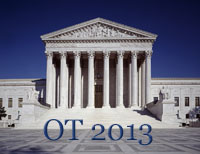 (This is another post in our series, Looking Back at the U.S. Supreme Court’s 2013 Term.) Last month I commenced a series of posts of the United States Supreme Court’s labor and employment law decisions last term by blogging on the Court’s decision in the First Amendment public employee free speech case of Lane v. Franks, No. 13-483 (June 19, 2014). In two separate blog posts, I will comment on two labor law Court decisions (NLRB v. Noel Canning and Harris v. Quinn) and two employee benefit/ERISA decisions (Burwell v. Hobby Lobby Stores, Inc. and Fifth Third Bancorp v. Dudenhoeffer). This post discusses the labor law cases.
(This is another post in our series, Looking Back at the U.S. Supreme Court’s 2013 Term.) Last month I commenced a series of posts of the United States Supreme Court’s labor and employment law decisions last term by blogging on the Court’s decision in the First Amendment public employee free speech case of Lane v. Franks, No. 13-483 (June 19, 2014). In two separate blog posts, I will comment on two labor law Court decisions (NLRB v. Noel Canning and Harris v. Quinn) and two employee benefit/ERISA decisions (Burwell v. Hobby Lobby Stores, Inc. and Fifth Third Bancorp v. Dudenhoeffer). This post discusses the labor law cases.
To begin, National Labor Relations Board v. Noel Canning, 134 S. Ct. 2550 (June 26, 2014), is obviously much more than just an ordinary labor law case. Yes, it concerns the validity of decisions made by the National Labor Relations Board (NLRB or Board) when it had a quorum based solely on presidential recess appointments from roughly January 2012 through August 2013. More specifically, on January 4, 2012, President Obama, faced with the prospect of another two-member Board (see below why this is a problem), used his constitutional recess appointment powers to make three intra-recess appointments. In an effort to prevent any intra-session appointments, the Republican-controlled House of Representatives refused to give its consent to the Democratic-controlled Senate to go into recess. See U.S. Const. Art. II, sec. 5 (“[n]either House, during the session of Congress, shall, without the consent of the other, adjourn for more than three days . . . .”). In response, the Senate held very brief, pro forma sessions in which no business was conducted.
So from a constitutional standpoint, Noel Canning concerns the President’s power to make recess appointments under Article II to fill federal agency positions. The Supreme Court held that the Recess Appointments Clause authorizes Presidents to fill existing vacancies during any recess, whether occurring during (intra-session) or between sessions (inter-session) of Congress – of sufficient length. Under this holding, the Senate is “in session” whenever it indicates that it is, as long as under its own rules it retains the capacity to transact Senate business. Because the recess appointments to the NLRB occurred during pro forma sessions of the Senate when the Senate retained the capacity to transact Senate business and because the three-day break during which time the President made the three recess appointments was insufficient to count as a recess, the Court unanimously decided (with a concurrence by Justice Scalia joined by three other Justices) that the recess appointments to the NLRB were invalid.
Now, I am not going to pretend to be a constitutional law expert for the simple reason that I am not. However, I can explain what impact this decision will have on the multitude of decisions that the Board made from January 2012 through August 2013. First, this type of situation where cases have to be potentially re-decided is not without precedent. In New Process Steel v. NLRB, 130 S. Ct. 2635 (2010), the Court found invalid two-Board-member decisions on grounds that the Board lacked a three-person quorum under Section 3(b) of the National Labor Relations Act (the Board’s full complement is five members – three from the President’s party and two from the other party). As a result, the Board had to re-decide and re-issue those cases decided by that two-member Board. Those New Process Steel decisions were, however, much less controversial than the decisions voided by Noel Canning because they involved decisions made by a two-member Board, one Democrat and one Republican, and thus were straight-forward decisions that did not break new ground.
According to NLRB General Counsel, Richard Griffin, 98 cases were related to the Board recess appointments pending in federal appellate courts when Noel Canning was decided. The Board has already set aside its decisions in more than 40 of those cases and has asked federal courts to remand dozens of other cases to the Board for appropriate action. Noel Canning also impacted Board decisions that did not move to the circuit court level. General Counsel Griffin has said that the parties likely will not have an interest in coming back to the board about a ruling that was satisfactory or a dispute that was resolved. On the other hand, if parties want to return to the NLRB, then Griffin may find it appropriate to bring cases back to the board for confirmation of earlier decisions if they involve unresolved issues about compliance with the NLRA or possible contempt of court. Finally, Griffin has acknowledged that decisions issued by the Board when it lacked a quorum of properly appointed members cannot be considered to have precedential value, but the current Board may find such rulings persuasive and may still follow their reasoning. In short, much aftermath at the Board in light of Noel Canning and much still to be decided.
As for Harris v. Quinn, 134 S. Ct. 2618 (June 30, 2014), the case concerned whether objecting home healthcare workers in Illinois could be required to pay union dues (an “agency fee”) under a union security clause. These home health care workers were considered public employees of the state of Illinois even though they worked in private homes. A “union security clause” is a provision in a labor contract that requires members of a union bargaining unit to pay at least some dues to the union representing them as a condition of employment. Under the Supreme Court’s decision in Abood v. Detroit Board of Education, 431 U.S. 209 (1977), public-sector workers have a First Amendment right not to be compelled (as a condition of employment) to fund political speech with which they disagree. Thus, union security clauses can only require dues payments for “collective-bargaining activities” but not for “ideological activities unrelated to collective bargaining.”
In a 5-4 decision, the Court held that the union security agreement that applied to these home healthcare workers violated their First Amendment rights. Justice Alito, writing for the majority, questioned Abood’s continuing viability on several grounds, but in the end chose to distinguish it rather than overturn it. Abood did not cover the employees here, the majority reasoned, because they were not “full-fledged public employees” but rather “partial public employees,” as they were almost entirely answerable to private customers. Further, they did not enjoy most of the rights other state employees have. In dissent, Justice Kagan defended Abood and argued that it covered the employees here. This case indicates that while at least some justices would prefer to overrule Abood, there are not five votes to do so, at least not currently. It would not surprise me if further test cases are filed by public sector workers covered by union security clauses who wish to see Abood overruled. In the meantime, union security clauses (at least in non-right-to-work states) remain viable for both private-sector and public-sector employees.
